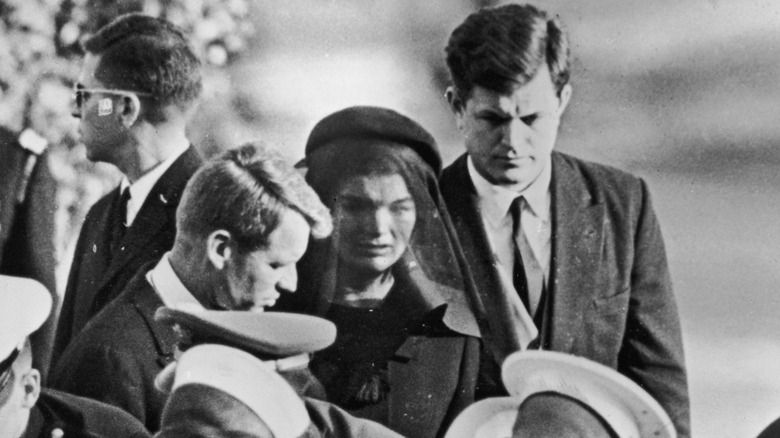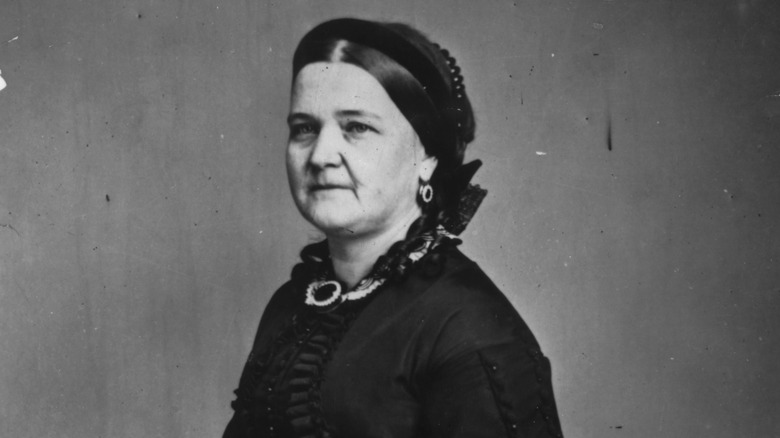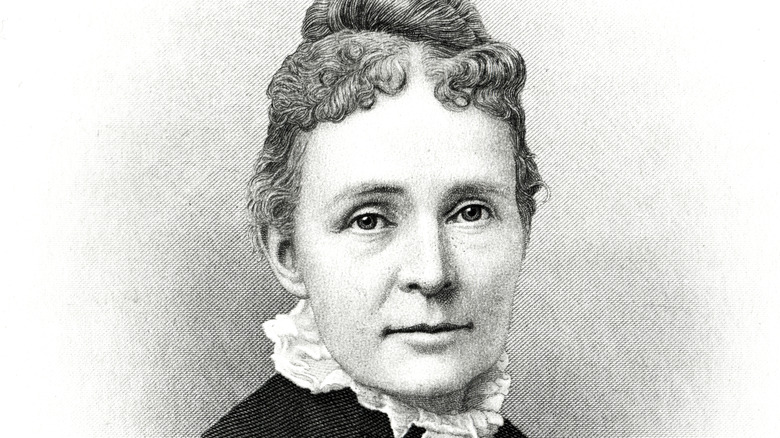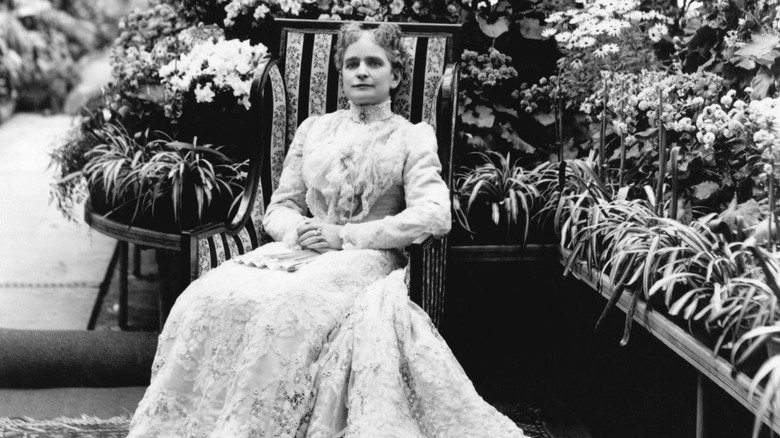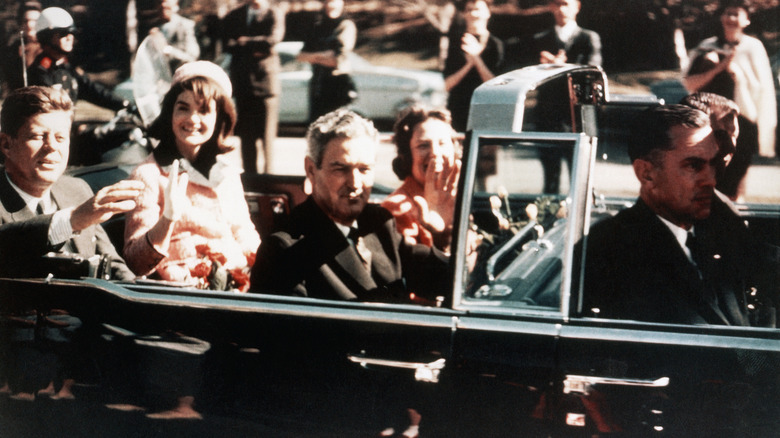Tragic Life Details Of Widowed First Ladies
American history tends to focus on the celebrated lives and tragic deaths of the U.S. presidents, especially if they met their end by an assassin's bullet, as was the case with Abraham Lincoln, James Garfield, William McKinley, and John F. Kennedy. But less discussed are the ill-fated lives of the widows they left behind. In some cases, these first ladies experienced heartbreaking pain both before and after their famous husbands died.
There was the harrowing fate of Mary Todd Lincoln, who was forced into a mental institution by her son a decade after her husband's assassination. Lucretia Garfield lost two of her young children to disease before her husband James became president and was recovering from malaria when he was shot and mortally wounded. She outlived him by nearly 40 years. For Ida McKinley, misfortune was nearly constant. She lost one daughter to disease at four months, then, two years later, her 3-year-old daughter died. Ida then began suffering headaches and seizures that plagued her for the rest of her life. In September 1901, an assassin's bullet took her husband from her. Jacqueline Kennedy suffered through her husband's affairs, had several traumatic pregnancies that included a stillbirth and the death of an infant, was at her husband's side when he was assassinated, and died of cancer at age 64.
Mary Todd Lincoln was institutionalized
Even before Mary Todd Lincoln's time as first lady, she had endured tragedy. In 1850, she and Abraham Lincoln's son Edward, called Eddie, died of tuberculosis before he'd turned 4. It only got worse after she became first lady. When the Civil War broke out, many Northerners questioned her loyalty since she came from a family of enslavers from Kentucky. Additionally, she was considered a spendthrift for overspending while redecorating the White House. Then, in 1862, their 11-year-old son Willie died of typhoid fever. Three years later, she was sitting next to her husband when John Wilkes Booth shot him in the back of the head.
In the years following the assassination, their other son Tad died of disease at 18, and Mary became even more obsessed with spiritualism, a practice she had taken up after Willie's passing. Then, in 1875, her last remaining son, Robert, forced her into a mental institution against her will. Whether or not she actually needed treatment continues to be debated. After her release, she went to Europe, where she hurt her back in a fall, and then returned to Illinois. Mary died at her sister's house in July 1882 after collapsing and falling into a coma. She was 63.
Lucretia Garfield was sick with malaria when her husband was shot
Lucretia and James Garfield lost two children before he became the 20th president. Their first child, Eliza, whom they called "Little Trot" after a Charles Dickens character, died of diphtheria before her fourth birthday. Thirteen years later, their son Edward died of whooping cough. He was almost two years old. Lucretia didn't want her husband to become president, but she supported him wholeheartedly when he won. It was to be a short stay at the White House for the Garfields. He had only been in office for four months when a disgruntled aspiring politician named Charles Guiteau shot him in the back at a train depot in Washington, D.C.
At the time of the shooting, Ida was recovering from malaria at a hotel in the seaside resort of Elberon, New Jersey. She returned to the White House and was by his side as he suffered agonizing pain from a bullet near his spleen doctors couldn't remove. They eventually moved the president to a hospital in Elberon, where he died of blood poisoning and other complications on September 19, 1881. After his death, Lucretia returned with her children to Ohio, where she stayed out of the public eye, oversaw her husband's legacy, and died in 1918.
Ida McKinley had a debilitating disease
Ida McKinley experienced a string of tragedies before and after her husband William McKinley became president. In the wake of the devastating death of her mother, Ida had a difficult pregnancy before giving birth to a daughter they named Ida. Sadly, the girl died as an infant. Two years later, their daughter Katie died at the age of 3. Later, Ida began suffering intense headaches and seizures that doctors at the time didn't understand (although it may have been epilepsy). The medications she took negatively affected her, and she became dependent on her husband. During William's presidential campaign, his enemies smeared his wife, accusing her of everything from spying for the British to being mentally ill. After he won the election, Ida, because of her illness, had a somewhat low-profile role at the White House.
Then, on September 6, 1901, when William was in Buffalo, New York, for the Pan-American Exposition, an anarchist named Leon Czolgosz shot him. Eight days later, the president died from a related infection. Ida, in deep mourning, returned to Ohio, and although she didn't attend her husband's burial, she visited his grave daily. She later oversaw the construction of a memorial for him. Ida McKinley died in 1907, probably due to the flu.
Jacqueline Kennedy witnessed JFK's assassination
The tragic true story of first lady Jacqueline Kennedy began before the assassination of her husband, President John F. Kennedy, and continued after his devastating death. As a child, her parents divorced, which at the time was less common and deeply affected young Jackie. After marrying Jack Kennedy, she was forced to give up her job as a newspaper journalist and photographer. According to some historians, she knew about and suffered through his many extramarital affairs. Jackie also had several difficult pregnancies, including a miscarriage in 1955 and a stillbirth the next year. Then, in August 1963, Jackie gave birth to a son, Patrick, who died two days later. (Two children, Caroline and John Jr., survived into adulthood.)
Just a few months later, on November 22, 1963, Jackie was in Dallas, Texas, with her husband in an open-top limousine when Lee Harvey Oswald shot JFK twice, one shot hitting him in the head. She was with him at the hospital when doctors called the time of death. In the years afterward, Jackie was hounded by the press. She remarried in 1968 and outlived her second husband, Aristotle Onassis, who died in 1975. Jackie died of non-Hodgkin lymphoma at age 64. She was just one of the first ladies who suffered through the horrific tragedy of losing a husband to an assassin's bullet, only to experience other calamities before and after.
